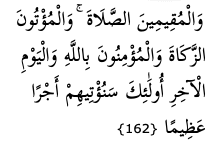
The underlying text – erased or wiped – of one of the San‘ā’ manuscripts contained the same spelling without diacritic dots. So how did the commentators try to skirt round this embarrassment? Did they agree to make their attempts contextual? Al-Tha‘labī said that he ‘got used to being left in a state of wondering about it’, while al-Sa‘dī argued that Maryam was here combining the sense of keeping loyal to her Lord while at the same intimidating this person and commanding him to be pious while they were both in solitude far from other people, and while he was dazzled by beauty.
BY JADOU JIBRIL
AL-BAGHAWI ARGUED that Maryam was saying “If you are a believer, do not oppress me” meaning that your piety should prevent you from immorality. And as regards the phrase “I will give to you”, al-Baghawi attributed this act to the messenger – the angel – even if the gift was actually from God since it was He who sent it. As for Ibn Kathir: “When she mentioned the Beneficent One, Jibrīl rose up and returned to his original form.” But did these commentators really succeed in overcoming embarrassment or did they simply make matters worse?
The case of Sūrat al-Nisā’ verse 162
But the firm in knowledge among them and the believers believe in what has been revealed to you and what was revealed before you, and those who keep up prayers and those who give the poor-rate and the believers in Allah and the last day, these it is whom We will give a mighty reward.
This verse contains an embarrassing problem that one inevitably had to simply avoid, and this is the Arabic grammar of the word for ‘those who keep up’ where the oblique case al-muqīmīn was used instead of the more correct nominative form al-muqīmūn. How did the slippery, apologetic mentality overcome this problem? It fabricated a scenario, like something filmed in a movie:
While a scribe was copying out the Qur’ān and had finished writing what came before the word al-muqīmīn he paused and was subsequently commanded to resume his work and told: “Carry on writing” (that is, continue your work) with the one commanding him saying: “Write those who keep up prayers [thus in the accusative case as object of the command] and in this way the phrase he used was correct – as opposed to al-muqīmūn and the scribe wrote down literally what he heard, without linking it to what went before.
They fabricated a scenario, like something filmed in a movie
There are other strange ‘explanations’ for rhetorical and other grammatical errors that attempted to get rid of the embarrassment. All of them, whether they knew it or not, strike a blow at the claims of ‘what was memorised in the breasts of men’ and ‘the Qur’ān is the literal word of God.’ Somewhat strangely al-Baghāwī’s commentary included an acknowledgement that ‘Ā’isha spotted the issue and considered it to be a scribal error. Even so, it was never corrected and has remained the same today in the breasts of the ḥāfiẓ memorizers and in the Qur’ānic text.
The case of Sūrat al-Ra‘d, verse 31
Is it: “Are those who have believed not despaired” or is it: “Are those who believe not understanding”?
The slippery, apologetic mentality found another way out of facing regarding other errors, by saying that the scribe was ‘tired’ or ‘overcome with sleep’ in order to explain away, for instance, the following divergence between “Are those who have believed not despaired” and “Are those who believe not understanding”? According to the Islamic narrative it is linked to the thesis of the Seven Letters[1] revealed in the Qur’ān. This raises a fundamental question regarding the issue of how to read the Seven or more Letters, whether these are real or simply another one of the mechanisms invented by the mercurial, apologetic mentality to avoid embarrassment.
The case of the hamza
When the diacritical letters, vocalisation, the long vowels (ā ī and ū) and the hamza (‘glottal stop’) were standardised, another hamza, one that had no specific letter form or positioning mark on the line (a kursī – ‘seat’) was added in the Qur’ān, and this a very long time after the revelation of the Qur’ān was completed. This led at times to its being written in a way that did not match its actual pronunciation, such as the word دعاء (du‘ā’ – ‘prayer’) which was written دعـؤا (du‘w’a) in sūrat Ghāfir. Even though this difference is simply one of how the writing of the Arabic language was developing over time, the mercurial, reverential, justificatory mentality persisted in providing doctrinal ‘explanations’ since it was in hock to the thesis that ‘the Qur’ān is the literal word of God and it is not permissible to challenge even how the words of the Qur’ān were written down. It thus fashioned doctrinal theories concerning the matter.
A doctrinal justification was deemed necessary since the mercurial mentality had adopted the idea that everything contained in the Qur’ān was divine
With regard to the above example of the writing of دعـؤا (du‘w’a), Shaykh Ibn al-Bannā’ al-Marrakushī opined the following:
This form refers to the type of supplication that appears on their tongues and not in their hearts… The letter alif has been added at the end to warn against the emergence of a prayer that is only on the tongue and not in the heart and in sincere feeling.[2]
Shaykh al-‘Arūsī said in his reference work al-Ganāwiyya[3]:
The word in the verse of sūrat Ghāfir with its omission of the letter alif and the writing of the hamza over the letter ‘w’ with an added alif at the end, is a hapax legomenon, and denotes that the prayers of the infidel cannot possibly be answered, and that having missed their chance they are now in Hell. And the word in the sūrat al-Ra‘d has a confirmed alif letter to denote that the prayers of the disbelievers made on earth are akin to their dreams which did not come true.
Why all these explanations, given that, the issue is one of humans writing, and not some divine act, and is the result of the development that the Arabic language witnessed in terms of grammatical rules and the techniques of the scribe, with no actual link with the sanctity of the Text? A doctrinal justification, nevertheless, was deemed necessary since the mercurial, reverential, justifying mentality had adopted the idea that everything contained in the Qur’ān was divine, and that its recording in script was no arbitrary matter. It was thus imperative to find a way out.
Examples of this process are many and numerous. The traditional Islamic mentality was thus forced to be mercurial, reverential and justifiable despite itself, not from some premeditated programme but out of a sincere belief that what it was venerating and justifying was absolutely and divinely true, one that could not admit of any falsehood or error.

Suggested Reading
The case of something lost from the Qur’ān
When it was being put about that part of the Qur’ān was lost, and that this was being confirmed in a number of narrations, the mercurial mentality did not throw down its slippery, apologetic justificatory weapons and acknowledge this fact but instead, as usual, searched for a way out. It found it in a response to what had been reported in the Jalāl al-Dīn al-Suyūṭī’s commentary work al-Durr al-Manthūr:
Say not that any of you have taken the whole Qur’ān and that what he knows of it is all that there is. A lot of the Qur’ān is missing … some say that what is meant by a text being abrogated referred solely to its oral recitation. [4]
It was, of course, necessary for the mercurial, reverential, justificatory mentality to find a way out of the embarrassment and save the dictum: ‘the Qur’ān has been preserved in the chests of men’ and equally the claim to ‘the saved tablet’[5] and the claims to sound hadith based on the plurality of its narrators[6] along with other claims, since how could that which had been preserved have anything of it lost? Naturally, no evidence or arguments was forthcoming since what concerned them was avoiding the embarrassment and getting rid of it. That any explanations for it simply insulted the intellect and turned those who accepted them into asses was of no importance.
[1] By ‘Seven Letters’ is meant the seven different versions of the Qur’ānic text, as revealed to the Prophet by Jibrīl in seven different aḥruf (‘letters’ understood as ‘modes’ or ‘styles’). Traditional scholars argue that the purpose of these variants was to allow the Qur’ān to spread more easily. (Ed.)
[2] Al-Marrakushī, عنوان الدليل من مرسوم خط التنزيل p.43.
[3] Shaykh ‘Abd al- ‘Azīz al-‘Arūsī, الݣناوية: منظومة أندلسية في تبث وحذف الألف في القرآن الكريم .
[4] الدر المنثور , Vol. II, p.298, with a sound chain of transmission from Ibn ‘Āmir.
[5] The concept of the ‘preserved tablet’ is taken from Qur’ān LXXXV (al-Burūj) 21-22: بَلْ هُوَ قُرْآنٌ مَجِيدٌ فِي لَوْحٍ مَحْفُوظٍ Nay, but it is a glorious Qur’ān, On a guarded tablet. The implications of this doctrine caused complications in the medieval period, with the controversy of the ‘createdness of the Qur’ān’. On this, see the Almuslih backgrounder paper on Khalq al-Qur’ān here. (Ed.)
[6] Hadiths labelled mutawātir were held to be unimpeachable if many narrated it, on the grounds that it was considered impossible for them all to agree to transmit a lie. See Glossary: Ḥadīth. (Ed.)
Main image: The San‘ā’ manuscript of the Qur’ān without any diacritical marks or vocalisation, first discovered in 1972 during renovations of the Great Mosque of San‘ā’ and radiocarbon dated to between 632–671 AD.
See Part One of this essay here

